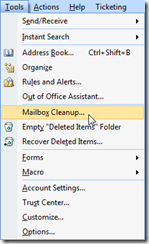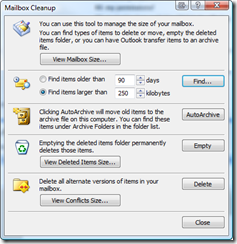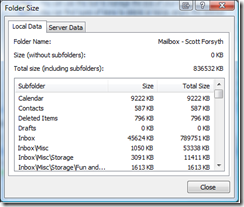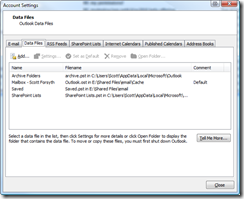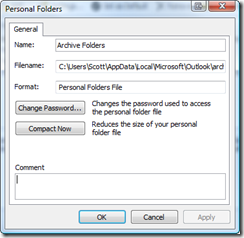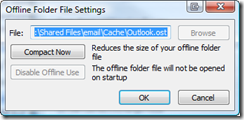Conquering Outlook 2007 Performance Issues
Outlook is one of those programs that's easy to have a love-hate relationship with. It offers so much, but the earlier versions have been plagued with stability and performance issues.
With the recent updates to Outlook 2007, stability has gotten substantially better. In fact, I don't remember Outlook crashing on me in months, which says a lot to the improvements that have been made. Performance on a tuned Outlook is very comfortable now too, so with the right love and care, Outlook 2007 can function very well for you.
At the time of this writing, two performance upgrades to Outlook were recently released and are well worth installing. They are http://support.microsoft.com/?kbid=968009 (cumulative update) and http://support.microsoft.com/?kbid=961752 (hotfix). There are a bunch of exciting performance enhancements there.
However, even with the latest of everything, Outlook got REALLY slow for me last week and needed some housekeeping. It was taking me 4 – 5 seconds to view each email, which for handling any amount of email in a day, is pretty much unusable.
I’m sure there are many additional ways to improve performance in Outlook, but I thought I would explain the couple that helped me this weekend.
First and foremost, any time I hear people complain about a slow Outlook, I always tell them to clean up their email and don’t store it all in their primary mailbox. Once they clean it up, it almost always returns to a good speed again. A bloated primary mailbox causes slow load times, slow running times and slow (or failed) shutdown. Additionally the search indexer works extra hard, causing the the entire computer to slow.
I checked the size of my Outlook.ost file and it was over 9GB! Oops. Note that I use Exchange Server with caching enabled. You may have a PST as your primary mailbox.
I used a 3-step approach to get my Outlook back in-line again.
- Clean up the obvious folders
- Find the non-obvious folders
- Compact the mailboxes
1. Clean up the obvious folders
There are many different ways to work with emails. I know that a lot of people like to delete their emails when they have finished reading them. I don’t work that way. I find that I go back to emails fairly often, so I keep pretty much all email except for spam or obvious junk. This causes my email count to climb at a fast rate, and years of email really adds up. I do, however, delete old email lists and newsletter emails since they are archived online or elsewhere.
If you’re one of the people that delete your read email, this first step may simply be to get to Inbox zero and delete your emails in the process.
For me, I create a “Saved” mailbox (PST file) and I drag and drop email older than a couple months there. I like to keep a couple months worth since I’m more likely to reference recent email, and it takes more effort to search for an email thread in my Saved mailbox than in my active mailbox.
2. Find the non-obvious folders
This step is what really helped me this time. I thought I had all of my normally large folders taken care of, but it was still taking me 4 – 5 seconds to view each email. I knew something was up, so I used Outlook’s handy Mailbox Cleanup tool to find out what I was missing. You can access this from Tools –> Mailbox Cleanup…
Mailbox Cleanup has a number of tools that come in handy for cleaning up your mailbox and speeding up Outlook. In this case, it was the View Mailbox Size tool that I used.
I was in for 2 surprises after running this. The first: I came to find out that I have a lot of emails in my Deleted Items folder. I had just emptied that folder so I wasn’t expecting to find anything. It turns out that I deleted everything in the root of the Deleted Items folder, but I missed the little + showing that there were subfolders that I overlooked.
Normally I delete using “Shift Delete” which bypasses the Deleted Items folder, but occasionally I don’t, and it looks like some folders I had deleted a long time ago were still sticking around.
I didn’t save a screenshot, but it was the Folder Size tools in the screenshot above that gave me what I needed.
The second surprise was the Sync folder. I had over 61,000 items in the Sync Issues/Conflicts folder! That was the greatest cause of performance issues. I did this over the weekend and I knew that I should be spending time with my family anyway, so I did a Select All on that folder (waited a long time) and then did a Shift Delete and left the laptop to do its stuff. A few hours later my laptop was available for use again.
Performance still wasn’t resolved, so I had more work ahead.
I had to ask myself why the Conflicts folder had grown like this. I don’t have it fully figured yet, but I found that part of it had to do with NOD32, my anti-virus program. It was touching the files on the way through and adding a signature to the files to say that they are scanned. That change caused Outlook to flag the message as a sync issue. I tweaked that setting and the new Conflicts are minimal now. I’ll continue to watch this and find out the cause for the rest.
3. Compact the mailboxes
Even though the mailboxes were down to a reasonable size, the performance issue remained. Outlook still needed to compact the mailboxes to reclaim that space.
The compact option is hidden away somewhat. You can get to it from Tools –> Accounts –> Data Files
Here if you want to look at the file itself, select the mailbox name and click on Open Folder…. The Compact Now button is in the mailbox settings.
For PST files, the button is on the first screen:
Click on Compact Now and let it do it’s stuff. Note that if it’s taking a while and you want to use your computer again, you can safely cancel it at any time and it will continue next time where it left off.
An exchange mailbox hides the Compact Now button even further. It’s in the Advanced tab –> Offline Folder File Settings …
It took another few hours for the compact to complete for me. I may have been faster just deleting the mailbox and creating it again, but I let it do its thing and it went from the bloated 9GB down to around 1GB. If I really wanted, I could get it smaller, but with it performing very fast again, there was no need.
That did it. My mouse clicks are measured in milliseconds now rather than seconds!
Outlook really has improved over the years and when looked after properly, it can serve you well.
